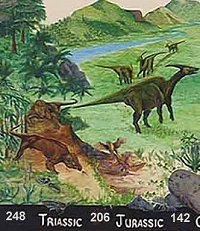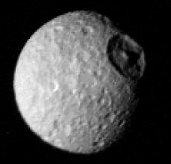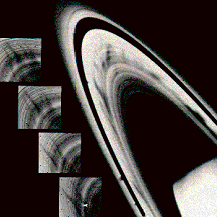|
Four hundred years after they were discovered,
Saturn's breathtaking rings remain a mystery.
by Dr Tony Phillips
Galileo Galilei was accustomed to extraordinary
discoveries. Using his primitive telescope he had found new worlds
orbiting Jupiter, watched planet-sized spots crossing the Sun, and
explored craters on the Moon. But when Galileo turned his telescope
toward Saturn in 1610, even he was amazed.
The planet looked nothing like others
in the solar system. Through 17th century optics, Saturn appeared
to be one bright star closely flanked by two dimmer ones - a blurry
suggestion of the planet's magnificent rings.
What Galileo did next was nearly as
unusual as Saturn itself.
He wanted to tell everyone what he
had seen, but he also wanted to keep his work secret while he studied
the puzzling planet. So, he published his discovery in
code: smais mr milmep oet ale umibunen ugttauir as. Unscrambled,
the anagram means "I have observed the highest planet tri-form."
Nowadays anyone with a department store
telescope can get a better view of Saturn's rings than Galileo did.
Otherwise, matters stand much as they did four hundred years ago.
First-time observers of the planet still step back from their telescopes
speechless. And scientists are still puzzled.
"After all this time we're still not
sure about the origin of Saturn's rings," says Jeff Cuzzi, a planetary
scientist at the NASA Ames Research Centre. Astronomers once thought
that Saturn's rings formed when Saturn did: 4.8 billion years ago
as the Sun and planets coalesced from a swirling cloud of interstellar
gas. "But lately," Cuzzi says, "there's a growing
awareness that Saturn's rings can't be so old."

Credit: Humboldt State University [more]
Saturn's rings
might have formed only a few hundred million years ago when
dinosaurs and their cousins roamed our planet.
|
Cuzzi speculates that some hundreds of
millions of years ago - a time when the earliest dinosaurs roamed
our planet - Saturn had no bright rings. Then, he says, something
unlikely happened: "A moon-sized object from the outer solar system
might have flown nearby Saturn where tidal forces ripped it apart.
Or maybe an asteroid smashed one of Saturn's existing moons." The
debris encircled the planet and formed the rings we see today.
Saturn's ring particles range in size
from microscopic dust to barn-sized boulders. If you assembled them
all in one place, notes Cuzzi, you would have enough material to
make an icy satellite one or two hundred kilometres wide - much
like Saturn's present-day moon Mimas.
The debris layer is extraordinarily
thin, he marvels. "Saturn's rings are 250,000 km wide, but only
a few tens of meters thick. A sheet of paper the size of San Francisco
would have about the same ratio of width to depth." Indeed, if you
made a 1-meter-wide scale model of Saturn, the rings would be 10,000
times thinner than a razor blade.
Cuzzi says there are two reasons to
believe the rings are young:
First, they are bright and shiny like
something new. It's no joke, he assures. The wide-spanning rings
sweep up space dust (bits of debris from comets and asteroids) as
Saturn orbits the Sun. Rings much older than a few hundred million
years would be darkened by accumulated dust. "The fact that they're
bright suggests they're young," he says.

Saturn's rings
are very thin. Astronomers using the Hubble Space Telescope
captured this image of the rings edge-on in 1995. Star-like
objects in the ring plane are icy satellites.
|
Second, small moons that orbit through
the outermost regions of the ring system are gaining angular momentum
at the expense of the rings. "During the next few hundred million
years," explains Cuzzi, "the outer half of the rings will fall toward
the planet, and the little moons - called shepherd satellites -
will be flung away. This is a young dynamic system."
The first argument (shiny rings) is
less certain than the second (angular momentum), he cautions, "because
we're not sure there's enough dust at the orbit of Saturn to pollute
and blacken the rings." NASA's Cassini spacecraft will measure the
dust population when it reaches Saturn in 2004. Then, perhaps, there
will be no doubt.

Saturn's 200
km-wide moon Mimas, also known as the "Death Star" satellite
because of its distinctive impact crater, is about as massive
as Saturn's rings.
|
Cuzzi hopes Cassini will solve other ring-mysteries,
too. "In the early '80's," he recalls, "the Voyager spacecraft visited
Saturn and took close-up pictures that revealed many strange things
in the rings, including spokes, braids and waves.
"Some of the waves have a spiral shape,
like the spiral arms of galaxies," says Cuzzi. To an astronaut floating
among the rings, such waves would appear to be gentle swells, a
few kilometres high and hundreds of kilometres wide. They move around
the rings every few days or weeks. "We understand these spiral waves,"
he added. They're triggered by gravitational tugs from Saturn's
moons - the same ones that are sapping the rings' angular momentum.
Other structures, like spokes and irregular
ripples, are puzzling. Some of them might be signs of space rocks
plunging through the ring system. Others might be spawned by tiny
moonlets, as yet undiscovered, plowing through Saturn's rings. "Cassini,
which will orbit Saturn for years, should provide some answers,"
he says.

Voyager 2 spacecraft
images of "spokes" and other irregular features in Saturn's
rings.
|
In many science fiction tales, alien visitors
are amazed by Saturn as if there were no ringed planets back in their
own solar system. According to Cuzzi, Saturn's rings might be rare
indeed. "If they are as short-lived as we think, we're lucky to be
here at just the right time to see them."
Actually, other giant planets in our
solar system do have rings, but they are very dark and millions
of times less massive than the rings of Saturn. Jupiter's rings
are made of bits of dust that fly off Jupiter's moons when they
are struck by meteorites. No one is sure what made the black rings
of Neptune and Uranus, although Cuzzi notes they could be debris
from kilometre-sized moonlets that were struck by asteroids.
In another few hundred million years,
if Cuzzi is right, Saturn's rings will sag inward and our solar
system will become a little more ordinary. Perhaps by then star-faring
humans will have seen countless ringed planets elsewhere in the
Galaxy and won't care much what happens to Saturn. On the other
hand, maybe Saturn's rings really are a Galactic wonder, and super-engineers
of the distant future will take measures to preserve them.
No one knows.
We can only be sure that Saturn's rings
are lovely now. And if they are indeed fleeting, as such ages are
reckoned for stars and planets, their short life makes them even
more wonderful. Don't miss them!
|
